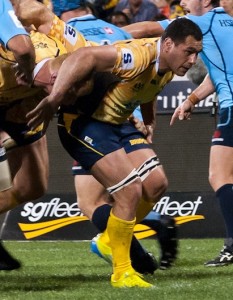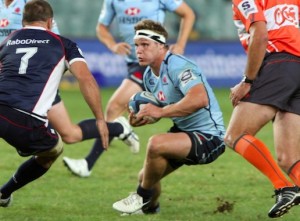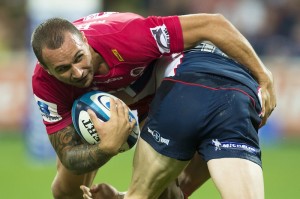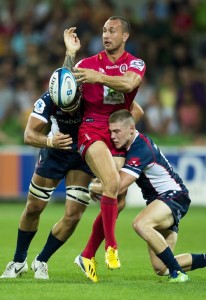Here’s my round up of Super Rugby round four, concentrating on the performances of the Aussie sides.
The Brumbies go up a gear

The form of the Brumbies from the first two weeks of the competition was good but after the bye last week it wasn’t maintained – it was exceeded!
While the Brumbies looked the complete package, with the unfortunate injury to David Pocock could they be as good? Fortunately Jake ‘Nostradamus’ White had covered for that possibility with the signing of George Smith. The veteran Brumby could have been forgiven for taking a few weeks to get back to the speed and intensity of Super Rugby after playing in Japan but he looked like he’d never been away.
Jesse Mogg continues to shred defences, particularly on the counter. If you’ve missed what he’s done take a look here at his 2013 highlights video so far. Can he continue with this form and if he does can Robbie Deans really ignore him? I think Jesse can and surely Robbie cannot.
As I said the Brumbies look like a complete team and in picking this week’s G&GR team of the week that’s where we started – list the best 15 from the Brumbies and then see if we could find any players from the other three Aussie teams that played that should be considered. Liam Gill was probably the only non-Brumby that just couldn’t be left out and whilst we ended up coming up with six non-Brumbies in total it was a close run thing to having 14 Brumbies in our team. Of course not everyone will always agree with our selections – feel free to give us your thoughts here.
Woe of the Waratahs – the breakdown
We couldn’t find any room for Waratahs players in our top 15 and I don’t recall seeing anyone seriously argue the case for any inclusions either. I posed the question last week whether the Waratahs would be able to offer a change-up in their game plan to take on the better performing teams in the competition but the performance on Saturday night looked more like a change-down.
I’ve expressed my surprise over the last few weeks about the Waratah’s width of forward support runners and lack of numbers getting into the breakdown early and both those issues helped to bring them undone against the Brumbies.
Securing quick, clean ball at the breakdown is a key precursor to being able to play attacking rugby as the Waratahs have said they want to. A team’s backrow are vital in helping to control the breakdown and all three members of the backrow need to work together. RugbyStats publish statistics showing which players are first into breakdowns and those numbers after the first four rounds are very interesting.

For the Brumbies Ben Mowen has led the way – having played 100% of the Brumbies minutes he has been first into 8% of breakdowns. Peter Kimlin is the next best with 7% having also played every minute. David Pocock has only played 68% of the minutes but was still first into 5% of breakdowns. George Smith has only played 29% of the minutes but has already been first into 3% of breakdowns. Combined, the Brumbies backrowers (and replacements) have been first into 26% of their breakdowns.
Scott Higginbotham has been the leading backrower for Aussie teams having been first into 9% of breakdowns for the Rebels. Those that claim he is a seagull whose work rate is poor may be surprised to learn that he is carrying the Rebels backrow with their next best being Scott Fuglistaller on 5%.
Liam Gill on 9% together with Ed Quirk and Jake Schatz on 8% each have led the way for the Reds whose backrowers (including replacements) have matched the Brumbies being first into 26% of their breakdowns.
When we look at those same statistics for the Waratahs the backrow has not been contributing as well. Michael Hooper has been doing his share of the work, being first into 8% of breakdowns and although Wycliff Palu has only played 49% of the minutes he’s on 5%. Dave Dennis has played 100% of the minutes, more than double the minutes of Palu, but has also only managed to be first into 5% of breakdowns.
The Waratahs backrow combined have only been first into 22% of breakdowns (15% below that of the Brumbies and Reds) and that difference is a result of the below par return from Dennis. Last year for the Brumbies Hooper was first into breakdowns 6% of the time so he’s lifted his work rate this year. Last year Dennis was first into the breakdown for the Waratahs 8% of the time and he really needs to lift his work rate back to that level.
After looking energized in the second half against the Rebels I’m sure Waratahs fans were expecting a lot more than was served up on Saturday. Michael Cheika has made it clear once again this week that the game plan won’t be changing and the players will have to change their ways – it’s interesting to see that he’s started wielding the selection stick this week as he tries to crash through the barriers that seem to be blocking the way.
[youtube id=”n0kFoe8tZSg” width=”600″ height=”350″]
The Reds – looking to lift

The Reds improved their play again with Quade Cooper having his best game of the season so far – he’s starting to see the opportunities early again, even though his execution to take advantage of those opportunities still isn’t up to the same level we’ve seen in the past.
The big surprise for me was Nick Frisby who has got obvious talent but has looked a little off the pace in previous matches this year. Given the extra responsibility of starting this week he really stepped up. When you think that Will Genia is due back this week and Ben Lucas should be fully fit the Reds halfback stocks look pretty good at the moment. The loss of Ian Prior, who left for the Brumbies after being a part of the 2011 championship winning team, and Matt Lucas, who left for the Waratahs this year, has not had much impact on depth in this area.
The standout player for the Reds, as I think he has been for each of the first four rounds, was Liam Gill. No doubt there’ll be a lot of discussion in the lead up to the selection of the first Wallabies squad this season as to whether Hooper or Gill should be the first choice number seven but with Pocock’s injury I’m sure that George Smith will come into calculations, even if it means resolving contract issues.
Rebels – O’Connors depth not the problem

The Rebels first half performance was good again and they took a slender lead into halftime but couldn’t score a single point in the second half, even though they had more possession than the Reds. That’s two matches in succession where they haven’t scored after halftime. Their defensive statistics actually improved in the second half against the Reds and I didn’t see any drop off in their defensive structures.
Where I think they’re coming undone is a lack of variation in attack – even with Kurtley Beale or James O’Connor at number ten they don’t have many options with their ball runners. Their attack looks a lot like that of a rugby league team with one out runners and an intention to recycle the ball rather than use patterns or plays designed to break the opposition’s defensive line within four or five phases. I think teams are recognising at halftime that there are very few threats and aiming to smother their one out runners in the second half.
I’ve seen lots of comments that James O’Connor’s performance showed he’s not a number ten as he stood too deep and ran the ball himself too much rather than passing. I don’t think he played particularly well but when you analyse the game in detail those arguments start to unravel.
A number ten needs to vary their play within each match – a mixture of running, passing and kicking to put the defence in two minds. They also need to vary their depth (sometimes starting from a flat position, sometimes deep) and alignment (sometimes starting in a wide position, sometimes much closer).
The statistics from ESPN tell us that O’Connor ran the ball 10 times, the same number as Quade Cooper with the only difference being that the number for O’Connor represented 11% of the Rebels total runs whilst Cooper’s only represented 8% of the Reds runs. The balance between running passing and kicking did show some differences between the two – O’Connor ran 29% of his possessions, passed 54% and kicked 17% – Cooper ran 19%, passed 64% and kicked 17%.
I’ve analysed how many times O’Connor and Cooper started from a deep position – 4 of 28 occasions where O’Connor didn’t kick (14%) and 7 of 43 for Cooper when he didn’t kick (16%). Despite starting from a deep position more than O’Connor did in that match I haven’t seen anyone suggest Cooper played too deep.
Of course there are two types of depth – firstly how deep you stand before the ball is passed and secondly how deep you are when you receive the ball. The second is the most relevant because as long as you move forward to receive the ball the impact of standing deep is minimised.
These still frames show how deep O’Connor received the ball on the 4 occasions I marked him as starting deep compared to the 4 occasions where Cooper received the ball the deepest.
 I estimate that the average depth O’Connor received the ball on those occasions was 10 metres and the same for Cooper.
I estimate that the average depth O’Connor received the ball on those occasions was 10 metres and the same for Cooper.
I had a 2007 Bledisloe Cup game on my screen for another project so out of interest I looked at the depth of Stephen Larkham in that match. Larkham was renowned for playing flat but he also varied his depth and in that match I marked him as starting deep on 12 occasions. The following still frames show where he received the ball on the 4 occasions where he received the ball deepest in that match.
I estimate the average depth Larkham received the ball on those four occasions was 11 metres so Larkham’s more extensive use of depth and the depth he was receiving the ball at shows that depth alone is not as big an issue as some people believe.
I’ve included this analysis to make the point that O’Connor’s depth in itself was not the issue – there is nothing wrong with depth if you’re going to pass the ball – the problem was that on three of the four occasions he started deep he ran the ball himself and that meant he was starting too far behind the gain line to be effective. That’s only three occasions in the match where he made the error but it is something he needs to improve – he should be looking to run the ball more, not less, but only when the runner on the previous phase gets over the gain line and the defence is therefore moving backwards when he can flatten up and take the ball to the line and be much more of a threat.




